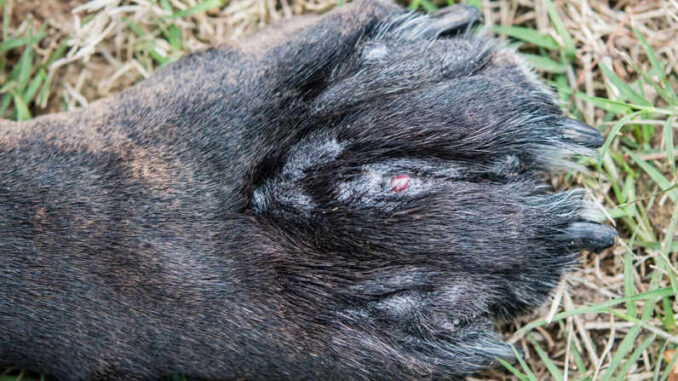
This article was updated on May 2nd, 2023
A dog with swollen paws or paw pads may be suffering from something as simple as a thorn in their paw to more serious conditions such as infections and even cancer. The medical term for a swollen paw in a dog is pododermatitis. In my veterinary hospital, I typically see a case of pododermatitis at least once a week. From my many years of experience as a veterinarian, I have learned that the most important part of treating a dog with swollen paws is to determine the underlying cause first.
In this article, we will discuss common appearances of swollen dog paws, their causes, and how they are treated.
What are the clinical signs of swollen paws (pododermatitis)?
Clinical signs are the things that a dog exhibits when they are suffering from a medical condition. When a dog has pododermatitis, the paws will typically be swollen, have reddened skin, have a foul smell, and have areas of hair loss. The appearance of the feet will vary depending on the cause. The dog may seem painful when the feet are touched and may lick them incessantly.
What does a swollen paw pad look like? [with pictures]
Several clinical signs are typically seen in dogs:
1. Swollen paws:
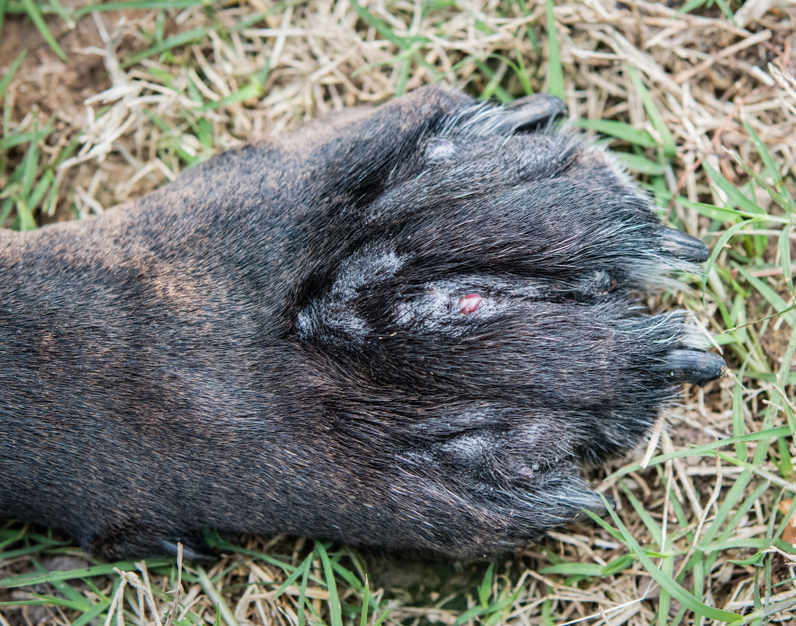
2. Red skin with hair loss from licking
Swollen paws are often accompanied by red skin or hair loss, as shown on the picture below. You can read our veterinarian article with tips to prevent dogs from licking their wounds.
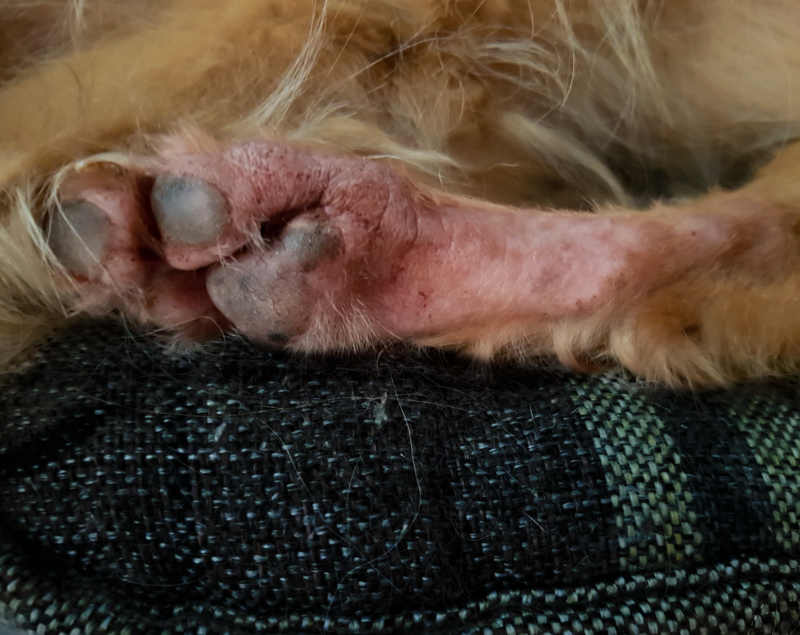
3. Lesions around toes
A closer inspection can sometimes reveal lesions, as shown on the picture below:
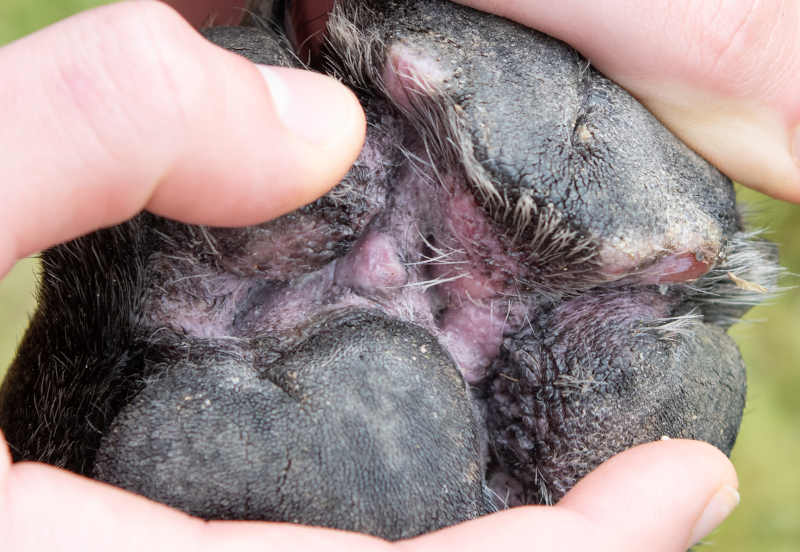
Cysts or other lesions can cause swollen dog paws, as shown below (cyst on a dog’s paw):
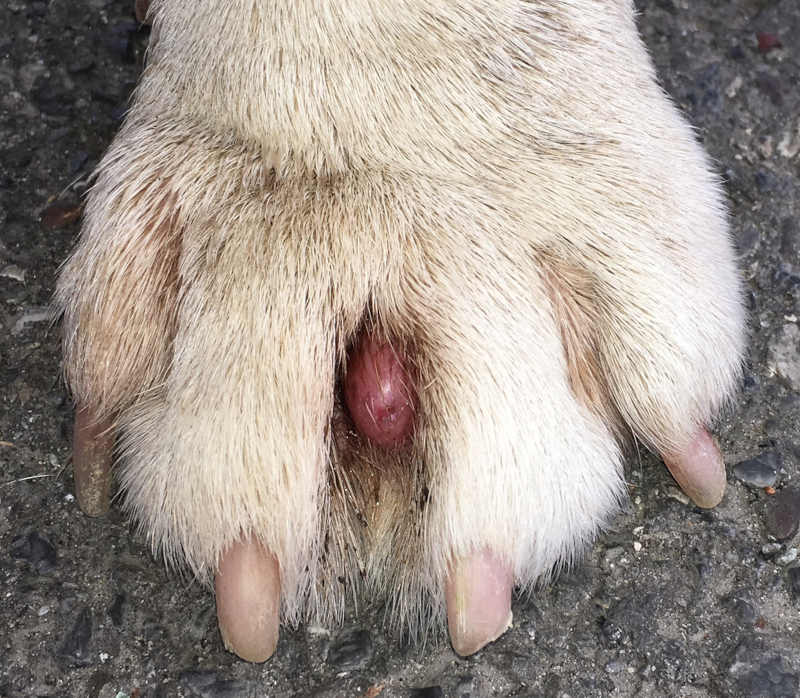
5 most common causes of swollen dog paws
There are many causes of swollen paws and paw pads in dogs. These include:
1. Allergies: One of the most common areas of the body to become itchy when a dog suffers from environmental allergies are the paws. A dog with allergies to something in their environment may lick their paws incessantly. The licking leads to irritation of the skin on the top of the feet as well as in between the toes. A pigment found in dog saliva, called porphyrin, may result in a reddish-brown colored staining of the fur where it has been licked.
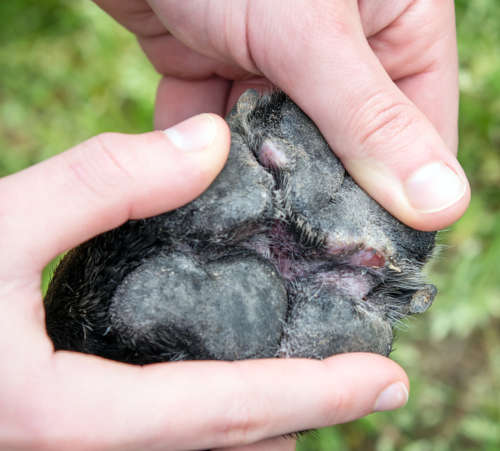
The location of the irritation on the paw can indicate what sort of allergy the dog is suffering from. If the cause is environmental allergies, known as atopy, the tops of the paws are most typically affected. If the dog is allergic to something that they have walked on, the bottom of the feet and paw pads are most typically affected.
Treatment for dogs suffering from swollen paws due to allergies include special diets, prescription allergy medications, supplements, and antibiotics if there is a secondary bacterial infection present. Veterinary costs will average from $200-$500 depending on the allergy and the severity. See more examples of swollen dog paw pads due to allergies: example 1, example 2.
2. Infections: Infections of the paws, both bacterial and fungal, can result in swollen feet. With infectious causes, you may also see lumps, bumps, and sores between the toes. Purulent discharge and a foul smell are common as well. These dogs are painful and typically lick their feet which results in hair loss and moistness.
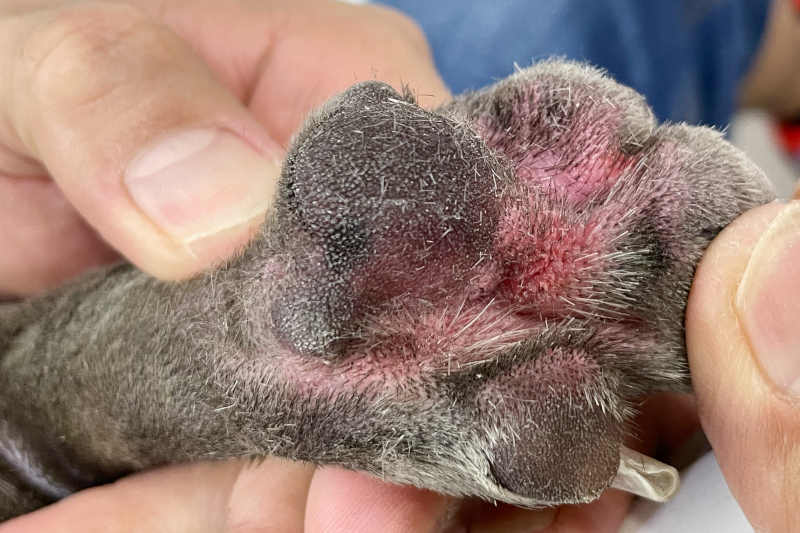
Treating a dog’s paw infection most often will require prescription antibiotics or antifungal medications. The total cost at the veterinarian will likely range from $100-$300. See another example picture for a dog paw infection or more more about common skin infections in dogs.
3. Cancer: unfortunately the paws are a fairly common location for cancer in dogs. In contrast to allergies and infections, usually only one foot is affected. Nail bed cancers may look like swelling, staining, and irritation around the base of the nail and usually only one nail bed is affected. Other cancers present as masses or nodules in between the toes and paw pads. As the cancer progresses, the area begins to bother the dog and they will lick and irritate the area further.
See example picture of cancer causing a swollen paw (Example 2, Example 3, Example 4)
A dog with cancer on its foot needs to be seen as soon as possible by their veterinarian. Treatments may include surgery to remove the cancer as well as toe amputation, radiation, chemotherapy, and immunomodulators. The treatment plan will need to be tailored depending on the type of cancer which will be determined with a biopsy. Costs to treat cancer in a dog vary widely based on the treatments needed, the type of cancer, and the severity of the disease process, but may range from $800-$5,000.
4. Autoimmune Disorders: Like humans, dogs commonly suffer from autoimmune disorders. One common area for these to manifest are on the paws, typically around the nail beds and the edges of the paw pads. With these disorders you will see crusting, flaking, scabbing, and small ulcers in these areas. Usually, all four feet of the feet are affected. The dog may also have similar lesions on their nose, around their eyes, and near the lip margins.
Treatment of canine autoimmune disorders is targeted at suppressing the dog’s overactive immune system as necessary. Steroids or other immunosuppressant medications will be required. Costs depend on the severity of the condition and length of treatment needed but range from $300-$1,000.
See example picture of a swollen dog paw pad due to an autoimmune disorder.
5. Injury: an injury to the paw can result in a swollen foot. Lacerations, crushing injuries, fractures, and foreign material such as thorns or other objects in the paw, all cause swelling, pain, and irritation.
Treating a dog’s paw injury will be tailored to the injury and may include suturing, splinting, medications, and sometimes, surgery. Costs range from $250-$1,200.
Do I need to worry about swollen paws / swollen paw pads?
Because your dog cannot talk and tell you what is bothering them, it is essential to determine the underlying cause for their swollen paws. Some conditions may be mild and self-limiting, but others are serious and if not diagnosed early, can result in lifelong pain and disability. If your dog’s paws are swollen for more than one day, they are licking them, or they seem painful to the touch, you should make them an appointment with their veterinarian as soon as possible.
Can a swollen paw pad sometimes heal on its own?
If the swollen paw is a result of a mild injury, such as a sprain, it may heal with no intervention. However, allergies, injuries, autoimmune disorders, and infections are miserable for your dog and should be addressed and treated by a veterinarian as soon as possible to relieve their suffering.
Steps to take at home now to help with your dog’s swollen paws
If your dog is suffering from a swollen paw or swollen paw pads, it can be soothing for them to soak the foot in a bath of warm water and Epsom salts. Be sure to dry the paw thoroughly afterward. Keep your dog quiet and warm and allow them to rest. Never give any medications, prescription or over the counter, without explicit permission from your veterinarian as this can easily be fatal.
What will happen at the vet?
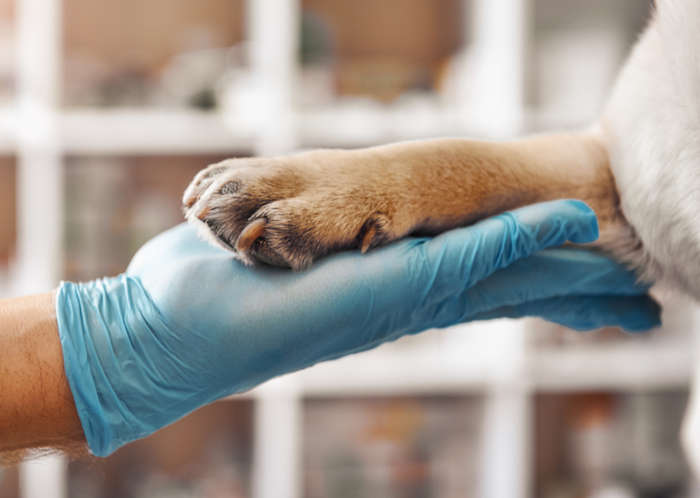
What You Should Know Before the Vet Visit
When taking your dog to the veterinarian for a swollen paw, make sure to note any medications they are taking, changes to their environment, when the problem started, and if you know the cause. If the issue has been going on for a bit of time, it can be helpful if you document the progression through pictures for your veterinarian.
Diagnosis
Your veterinarian will perform a thorough physical exam and also obtain a detailed history. Diagnostics will be chosen based on these findings. These may include skin scrapings, tape cytology, biopsies, cultures, and radiographs (x-rays).
Recovery expectations
After treatment, your dog’s paws should likely go back to normal fairly quickly. Of course, this is highly dependent on the initial cause. Allergies cannot be cured but must be continually managed throughout a dog’s life. Severe injuries and cancer can have more severe effects on your dog’s life than more minor ailments. Always talk to your veterinarian and ask about healing expectations and future management.
Swollen Dog Paws: FAQs with the Vet
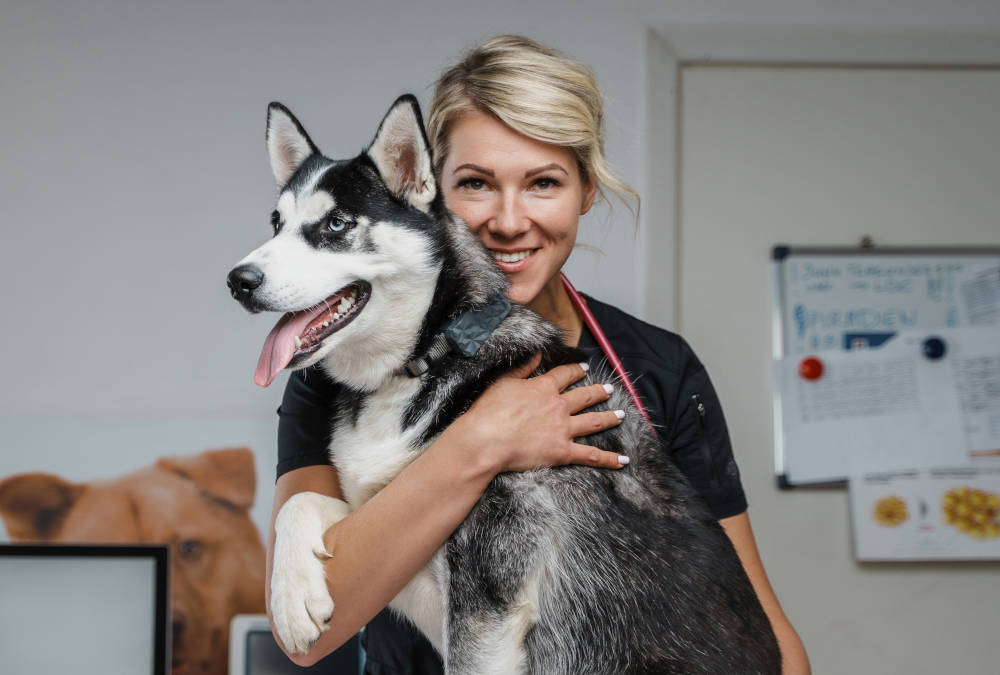
What does a swollen paw look like when it’s infected?
A dog that has an infection in their paw will likely be licking the area incessantly. There will be redness, possible hair loss, brownish red staining, and discharge.
Can I give my dog Benadryl for a swollen paw?
Though Benadryl (diphenhydramine) is not toxic to dogs at appropriate doses, you should not give this medication to your dog without express permission from your veterinarian. Diphenhydramine is an antihistamine and will be unlikely to help the causes of swollen paws in dogs. Though allergies are one of the more common causes, dog’s allergies are not histamine medicated to the extent that human’s allergies are, and therefore giving this medication is unlikely to work.
Related posts about paw issues:
 Dog Paw Allergy Issues: 6 Tips to Help Your Dog [With Pictures] - One of my pet parents brought her dog into the clinic because he was furiously licking and chewing on his… [...]
Dog Paw Allergy Issues: 6 Tips to Help Your Dog [With Pictures] - One of my pet parents brought her dog into the clinic because he was furiously licking and chewing on his… [...] White Bumps on a Dog’s Paw: Most Likely Reasons - If you’ve noticed a new white bump or lump on your dog’s paw you’re probably wondering what’s causing it. White… [...]
White Bumps on a Dog’s Paw: Most Likely Reasons - If you’ve noticed a new white bump or lump on your dog’s paw you’re probably wondering what’s causing it. White… [...] 4 Cysts Often Found on Dog Paws [With Pictures & Vet Advice] - Ahh dog feet, giant Great Dane Marmaduke paws, tiny terrier tootsies, the puffy, fluffy white feet of a Bichon Frisé.… [...]
4 Cysts Often Found on Dog Paws [With Pictures & Vet Advice] - Ahh dog feet, giant Great Dane Marmaduke paws, tiny terrier tootsies, the puffy, fluffy white feet of a Bichon Frisé.… [...] Paw Yeast Infections in Dogs: What They Look Like & What To Do - When most people think of yeast, the first thing to come to mind would probably be a freshly baked loaf… [...]
Paw Yeast Infections in Dogs: What They Look Like & What To Do - When most people think of yeast, the first thing to come to mind would probably be a freshly baked loaf… [...]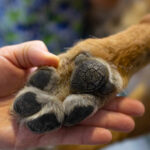 8 Paw Lumps, Bumps & Sores in Dogs [With 16 Pictures] - Seeing skin issues is a nearly everyday thing for us at our veterinary clinic. This article will help you identify… [...]
8 Paw Lumps, Bumps & Sores in Dogs [With 16 Pictures] - Seeing skin issues is a nearly everyday thing for us at our veterinary clinic. This article will help you identify… [...]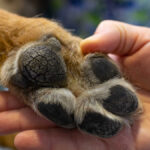 Dog with Cracked Paws? Our Veterinarian Explains What to Do - A dog’s feet often seem indestructible. After all, they’re on the go in all types of terrain, allowing your dog… [...]
Dog with Cracked Paws? Our Veterinarian Explains What to Do - A dog’s feet often seem indestructible. After all, they’re on the go in all types of terrain, allowing your dog… [...]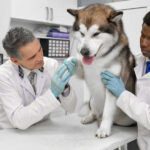 Dog Paw Infections and Issues: Pictures & Vet Advice - Dog paw infections are one of the more common issues that we treat in our veterinary hospital: dogs often excessively… [...]
Dog Paw Infections and Issues: Pictures & Vet Advice - Dog paw infections are one of the more common issues that we treat in our veterinary hospital: dogs often excessively… [...] Why Is My Dog Constantly Licking His Paws? Veterinarian Advice - You may notice your dog licking his paws on occasion. This is often just part of his everyday grooming routine;… [...]
Why Is My Dog Constantly Licking His Paws? Veterinarian Advice - You may notice your dog licking his paws on occasion. This is often just part of his everyday grooming routine;… [...]Disclaimer: This website's content is not a substitute for veterinary care. Always consult with your veterinarian for healthcare decisions. Read More.


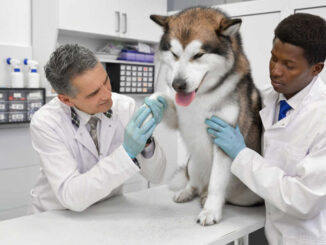
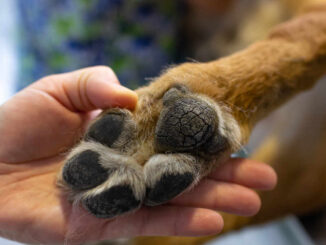
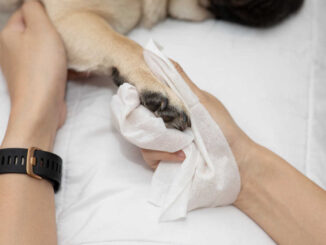
Be the first to comment